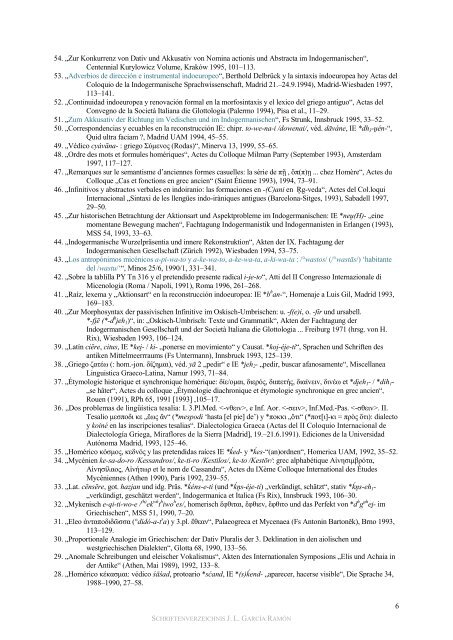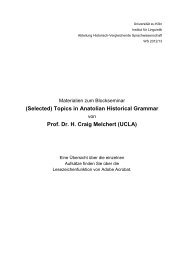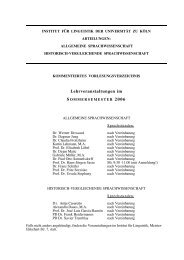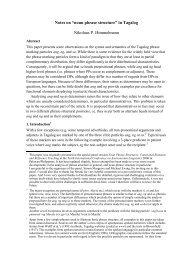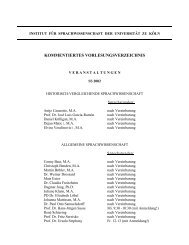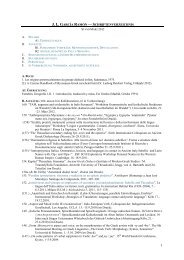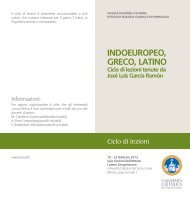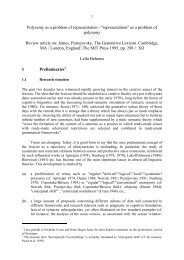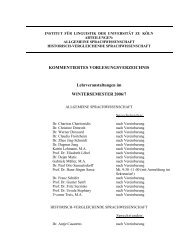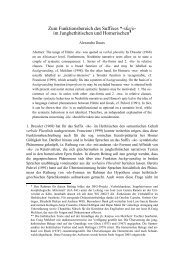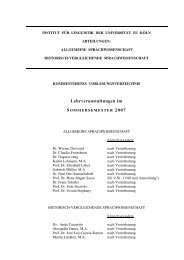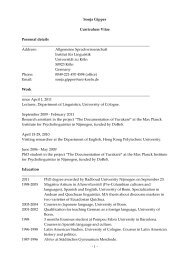Gesamtverzeichnis (pdf) - Institut für Linguistik - Universität zu Köln
Gesamtverzeichnis (pdf) - Institut für Linguistik - Universität zu Köln
Gesamtverzeichnis (pdf) - Institut für Linguistik - Universität zu Köln
You also want an ePaper? Increase the reach of your titles
YUMPU automatically turns print PDFs into web optimized ePapers that Google loves.
54. „Zur Konkurrenz von Dativ und Akkusativ von Nomina actionis und Abstracta im Indogermanischen“,<br />
Centennial Kurylowicz Volume, Kraków 1995, 101–113.<br />
53. „Adverbios de dirección e instrumental indoeuropeo“, Berthold Delbrück y la sintaxis indoeuropea hoy Actas del<br />
Coloquio de la Indogermanische Sprachwissenschaft, Madrid 21.–24.9.1994), Madrid-Wiesbaden 1997,<br />
113–141.<br />
52. „Continuidad indoeuropea y renovación formal en la morfosintaxis y el lexico del griego antiguo“, Actas del<br />
Convegno de la Società Italiana die Glottologia (Palermo 1994), Pisa et al., 11–29.<br />
51. „Zum Akkusativ der Richtung im Vedischen und im Indogermanischen“, Fs Strunk, Innsbruck 1995, 33–52.<br />
50. „Correspondencias y ecuables en la reconstrucción IE: chipr. to-we-na-i /dowenai/, véd. dāváne, IE *dh3-u̯ én-“,<br />
Quid ultra faciam ?, Madrid UAM 1994, 45–55.<br />
49. „Védico cyávāna- : griego Σύμεvoς (Rodas)“, Minerva 13, 1999, 55–65.<br />
48. „Ordre des mots et formules homériques“, Actes du Colloque Milman Parry (September 1993), Amsterdam<br />
1997, 117–127.<br />
47. „Remarques sur le semantisme d’anciennes formes casuelles: la série de πῇ , ὅπ(π)ῃ ... chez Homère“, Actes du<br />
Colloque „Cas et fonctions en grec ancien“ (Saint Étienne 1993), 1994, 73–91.<br />
46. „Infinitivos y abstractos verbales en indoiranio: las formaciones en -(C)ani en R̥ g-veda“, Actes del Col.loqui<br />
Internacional „Sintaxi de les llengües indo-iràniques antigues (Barcelona-Sitges, 1993), Sabadell 1997,<br />
29–50.<br />
45. „Zur historischen Betrachtung der Aktionsart und Aspektprobleme im Indogermanischen: IE *neu̯ (H)- „eine<br />
momentane Bewegung machen“, Fachtagung Indogermanistik und Indogermanisten in Erlangen (1993),<br />
MSS 54, 1993, 33–63.<br />
44. „Indogermanische Wurzelpräsentia und innere Rekonstruktion“, Akten der IX. Fachtagung der<br />
Indogermanischen Gesellschaft (Zürich 1992), Wiesbaden 1994, 53–75.<br />
43. „Los antropónimos micénicos a-pi-wa-to y a-ke-wa-to, a-ke-wa-ta, a-ki-wa-ta : /°wastos/ (/°wastās/) ‘habitante<br />
del /wastu/‘“, Minos 25/6, 1990/1, 331–341.<br />
42. „Sobre la tablilla PY Tn 316 y el pretendido presente radical i-je-to“, Atti del II Congresso Internazionale di<br />
Micenologia (Roma / Napoli, 1991), Roma 1996, 261–268.<br />
41. „Raíz, lexema y „Aktionsart“ en la reconstrucción indoeuropea: IE *b h an-“, Homenaje a Luis Gil, Madrid 1993,<br />
169–183.<br />
40. „Zur Morphosyntax der passivischen Infinitive im Oskisch-Umbrischen: u. -f(e)i, o. -fír und ursabell.<br />
*-fi̯ ē (*-d h i̯ eh1)“, in: „Oskisch-Umbrisch: Texte und Grammatik“, Akten der Fachtagung der<br />
Indogermanischen Gesellschaft und der Società Italiana die Glottologia ... Freiburg 1971 (hrsg. von H.<br />
Rix), Wiesbaden 1993, 106–124.<br />
39. „Latín ciēre, citus, IE *kei̯ - / ki- „ponerse en movimiento“ y Causat. *koi̯ -éi̯ e-ti“, Sprachen und Schriften des<br />
antiken Mittelmeerrraums (Fs Untermann), Innsbruck 1993, 125–139.<br />
38. „Griego ζατέω (: hom.-jon. δίζημαι), véd. yā 2 „pedir“ e IE *i̯ eh2- „pedir, buscar afanosamente“, Miscellanea<br />
Linguistica Graeco-Latina, Namur 1993, 71–84.<br />
37. „Étymologie historique et synchronique homérique: δίε/oμαι, διερός, διιπετής, διαίvειv, διvέω et *di̯ eh1- / *dih1-<br />
„se hâter“, Actes du colloque „Étymologie diachronique et étymologie synchronique en grec ancien“,<br />
Rouen (1991), RPh 65, 1991 [1993] ,105–17.<br />
36. „Dos problemas de lingüística tesalia: I. 3.Pl.Med. , e Inf. Aor. , Inf.Med.-Pas. . II.<br />
Tesalio μεσπoδι κε „ἕως ἄν“ (*mespodi ‘hasta [el pie] de’) y *πoκκι „ὅτι“ (*πoτ[ι]-κι = πρὸς ὅτι): dialecto<br />
y koiné en las inscripciones tesalias“. Dialectologica Graeca (Actas del II Coloquio Internacional de<br />
Dialectología Griega, Miraflores de la Sierra [Madrid], 19.–21.6.1991). Ediciones de la Universidad<br />
Autónoma Madrid, 1993, 125–46.<br />
35. „Homérico κόσμoς, κεδvός y las pretendidas raíces IE *ḱed- y *ḱes-“(an)ordnen“, Homerica UAM, 1992, 35–52.<br />
34. „Mycénien ke-sa-do-ro /Kessandros/, ke-ti-ro /Kestilos/, ke-to /Kestōr/: grec alphabétique Aἰvησιμβρότα,<br />
Αἰvησίλαoς, Αἰvήτωρ et le nom de Cassandra“, Actes du IXème Colloque International des Études<br />
Mycéniennes (Athen 1990), Paris 1992, 239–55.<br />
33. „Lat. cēnsēre, got. hazjan und idg. Präs. *ḱéns-e-ti (und *ḱn̥ s-éi̯ e-ti) „verkündigt, schätzt“, stativ *ḱn̥ s-eh1-<br />
„verkündigt, geschätzt werden“, Indogermanica et Italica (Fs Rix), Innsbruck 1993, 106–30.<br />
32. „Mykenisch e-qi-ti-wo-e / (h) ek wh t h iwo h es/, homerisch ἔφθιται, ἔφθιεv, ἔφθιτo und das Perfekt von *d h g u̯ h ei̯ - im<br />
Griechischen“, MSS 51, 1990, 7–20.<br />
31. „Eleo ἀνταπoδιδῶσσα (°didó-a-t s a) y 3.pl. ἔθεαν“, Palaeogreca et Mycenaea (Fs Antonin Bartoněk), Brno 1993,<br />
113–129.<br />
30. „Proportionale Analogie im Griechischen: der Dativ Pluralis der 3. Deklination in den aiolischen und<br />
westgriechischen Dialekten“, Glotta 68, 1990, 133–56.<br />
29. „Anomale Schreibungen und eleischer Vokalismus“, Akten des Internationalen Symposions „Elis und Achaia in<br />
der Antike“ (Athen, Mai 1989), 1992, 133–8.<br />
28. „Homérico κέκασμαι: védico śāśad, protoario *sćand, IE *(s)ḱend- „aparecer, hacerse visible“, Die Sprache 34,<br />
1988–1990, 27–58.<br />
SCHRIFTENVERZEICHNIS J. L. GARCÍA RAMÓN<br />
6


